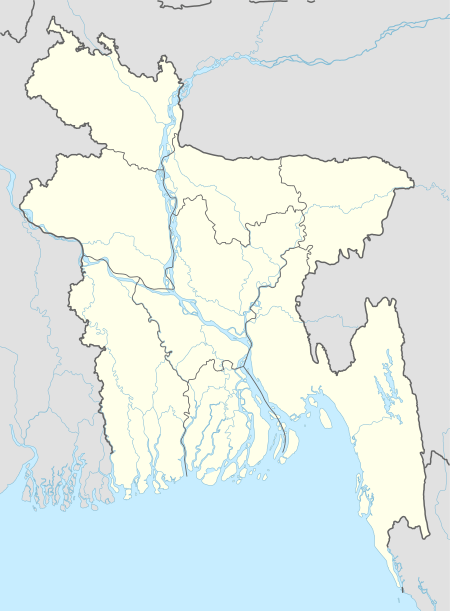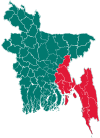Lohagara Upazila, Chittagong
Lohagara (Bengali: লোহাগাড়া) is an Upazila of Chittagong District[1] in the division of Chittagong, Bangladesh. Lohagara is situated between Chittagong and Cox's Bazar. It is one of the largest and most densely populated upazilas of Bangladesh.[2]
Lohagara লোহাগাড়া | |
|---|---|
Upazila | |
 Lohagara Location in Bangladesh | |
| Coordinates: 22°0.5′N 92°6.3′E | |
| Country | |
| Division | Chittagong Division |
| District | Chittagong District |
| Area | |
| • Total | 258.87 km2 (99.95 sq mi) |
| Population (1991) | |
| • Total | 203,453 |
| • Density | 786/km2 (2,040/sq mi) |
| Time zone | UTC+6 (BST) |
| Website | lohagara |
Etymology
In 1660, Mughal prince Shah Shuja took shelter in the Kingdom of Arakan to escape from Mir Jumla II. While heading to Arakan, he stayed in a beautiful hilly place (present-day Chunati) between Chittagong and Cox's Bazar for a few days. At the time of departure, he engraved an iron bar in that place as a sign. It is thought that because of engraving iron bar by Shah Shuja the area is called 'Lohagara' since 'Loha' means 'iron'.
History
Lohagara was once under Satkania Upazila. Lohagara thana was formed in 1981 and it was turned into an upazila in 1983.
Geography

Lohagara is located at 22.0083°N 92.1056°E. It has 33,981 households and a total area of 258.87 square kilometres (99.95 sq mi). It is bordered by Satkania Upazila on the north, Chakaria and Lama Upazilas on the south, Bandarban Sadar and Lama Upazilas on the east and Banshkhali Upazila on the west. The noted canals are Tonkaboti, Dolu and Hangor.
Parks and greenery
- Chunati Wildlife Sanctuary
- Padua Forest Range
- Nasim Park
Administration
Lohagara thana was turned into an upazila in 1983. The upazila consists of nine union parishads, 40 mouzas and 43 villages. The largest union is Barohatia and the largest village is Rashider Ghona.
The nine union parishads are:
- Barohatia Union
- Amirabad Union
- Padua Union
- Charamba Union
- Kolaujan Union
- Lohagara Union
- Putibilla Union
- Chunati Union
- Adhunogor Union
Demography
As of 2001, the population of Lohmalesa upazila was 2,66,741. Of these, 1,34,094 were male and 1,32,647 are females. The total population was 89% Muslim, 9% Hindu, 2% Buddhists and other religions.
Culture
The culture of this area has been developed through the lives of people of different opinions. In the past, there were foreign merchants here with seemingly different ethnicity and existences.
Architecture

- Chunti Khan Mosque
- Upazila Memorial Museum
- Central Mosque
- Gupta Landlord House (Padua)
- Gupta Landlord House (Aduonagor)
Education
The literacy rate of Lohagara Upazila is 44.6%, with male literacy at 42.40% and female at 25.03%.
There are one kamil madrasas, two degree colleges (two honors courses), one mohila College (the only govt. college in Lohagara Upazila), nine fazil madrasas, one technical college, one school and college, 1 alim madrasas, 25 secondary schools (1 govt), 18 dakhil madrasas, two quami madrasas, 10 lower secondary schools, 105 primary schools, 43 ebtedi madrasas, and 30 kindergartens.
Schools
- Amirabad Janakalyan High School (1970)
- North M B Amirabad High School (1932)
- South Satkania Golambari Govt. High School (1937)
- Charamba High School
- Lohagara Suckchuri Uzir vita
- M. H. Nurul Alam Chowdhury Ideal High School (1994)
- Kalauzan Gorsundar High School (1945)
- Adhunagar High School (1961)
- Padua A.C.M. High School (1963)
- Lohagara Shahpir Pilot High School (1966)
- Mustafa Begum Girls High School
- Chunati High School
- B G Senerhat High School
- Sukchari High School (1986)
- Kalauzan Dr. Yakub Bazlur Rahman Sikder High School
- Uttar Padua High School (1996)
- Lohagara Ideal School & College
- Iqra Abdul Jabbar High School (1988)
Madrashas
- Barahatia Malpukuria Miaskatul Ulum Madrasah (1941)
- Chunati Hakimia Kamil (M.A) Madrasah
- Amirabad Sufia Aliya Madrasah
- Rajghata Hossainia Azizul Uloom Madrasah
- Lohagara Islamia Fazil (Degree) Madrasah (1945)
- Al-Ihsan Academy, Lohagara (1997)
- South Sukchari Shah Abdul Khalek Fazil (degree) Madrasa
- Kalauzan Shah Rashidia Fazil (degree) Madrasah
- Barohatia Darul Quran Academy (2015)
- Islamia Fazil Madrasha, Adhunagor
Colleges and universities
- Alhaj Mostafizur Rahman University College
- Baro Aulia University College
- Mostafa Begum Girls Business Management College
- Chunati Govt. Mahila College
- Ayub Foundation Technical College
Health
There are 1 Upazila health center, 5 family planning Centers, 4 union health centers, clinics, and 16 diagnostic centers. Sanitary system: 49.24% of the area (53.96% in rural and 48.69% in urban) is healthier and 34.55% (33.95% in villages and 39.68% of urban households) use non-sanitary latrines. 16.22% of households do not have latrine facilities.
Economy
The main sources of community income are: Agriculture 39.29%, non-agricultural laborer 5.40%, industry 0.82%, business 17.71%, transport and communication 3.43%, employment 14.58%, construction 1.59%, religious services 0.49%, Rent and remittance 5.19% and other 11.50%.
Ownership of agricultural land: Landowner 63.88%, landless 36.12%. 64.13% of the city and 61.74% of the rural households have agricultural land.
Main crops: paddy, potato, sugarcane, chilli, fellong
Extinct or nearly extinct crops: stil, linseed, watermelon
Main fruits: banana, papaya, guava, amra, plum
Fisheries, dairies and poultries: fishery 2322 (pond), hatchery (fishery) 22, poultry 5, poultry 139
Industries and factories: rice mill, ice factory, biscuit factory, textile mill, plywood factory
Cottage industries: goldsmith, blacksmith, potteries, stools, mesh fabric, bamboo work, woodwork
Haats and fairs: 24 haats and bazars, three fairs (noted among them is Dervay Haat), Tawari Hat, Khaatat Hat, Hindu Hat, Sener Hat and Manufakir Hat
The main export is the scraping, fake, ready-made garments.
Notable residents
- Bulbul Chowdhury, pioneer of modern dance in Bangladesh, born in Chunati in 1919
- Major Nazmul Huq, Sector Commander, 7th sector of Bangladesh Liberation War (March to August 1971), born at Amirabad village in 1938
References
- Md. Abul Manjur (2012), "Lohagara Upazila (Chittagong District)", in Sirajul Islam and Ahmed A. Jamal (ed.), Banglapedia: National Encyclopedia of Bangladesh (Second ed.), Asiatic Society of Bangladesh
